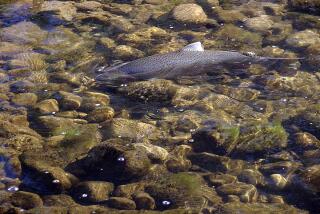Salmon Stakes
EUREKA, Calif. — Every year, Steve Sanders plays the role of matchmaker, obstetrician and pediatrician to the salmon and steelhead trout that pass through the Prairie Creek Fish Hatchery north of here in Humboldt County.
Sanders, supervisor of the county-operated hatchery, hopes to nab about 100 salmon this year as they pass through the hatchery’s fish ladder and keep them in a pool until they are ripe for spawning.
“I can tell when they’re ready by feeling their bellies; if the skin is taut like a drum we wait a while longer, if it’s loose and flabby they’re ripe,” Sanders said.
Each female produces 3,000 to 5,000 eggs, which are removed by hand and put into a plastic pan full of water. The sperm are taken from the male and mixed in with the eggs.
Once the eggs are fertilized, Sanders keeps them in an incubator for about 60 days until they hatch. After hatching, the fish are kept in small troughs until they measure 1 1/2 inches in length, at which time they are moved to large outdoor pools. When they measure about seven inches they are released into the river.
After the salmon make their way back out to the ocean they are prey to otters, birds, sharks and sea lions. Most of the survivors are caught by commercial fishermen, Sanders said.
Three to four years later, however, about 1.5% of the original “crop” returns to Prairie Creek to spawn.
“We can always tell our own because we fin clip them,” Sanders said.
A large portion of his wards end up tinned or frozen in the supermarket but Sanders says he doesn’t mind.
“We need the commercial salmon fishing industry,” he said. “It’s important to this part of the coast.”
More to Read
Sign up for Essential California
The most important California stories and recommendations in your inbox every morning.
You may occasionally receive promotional content from the Los Angeles Times.










